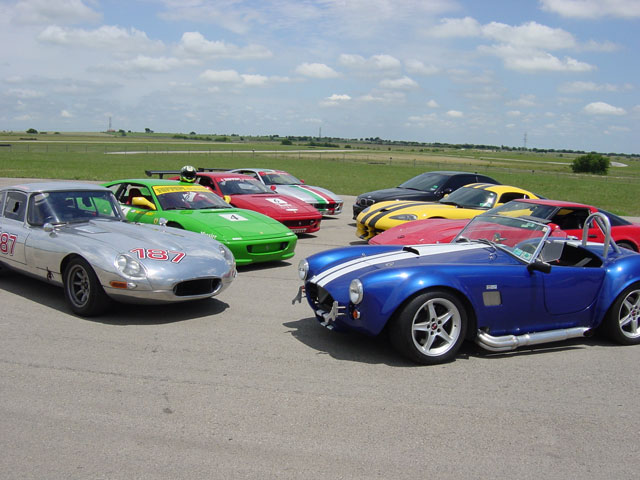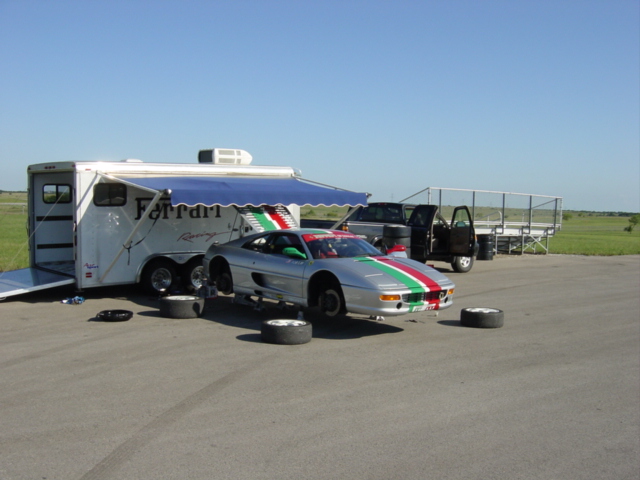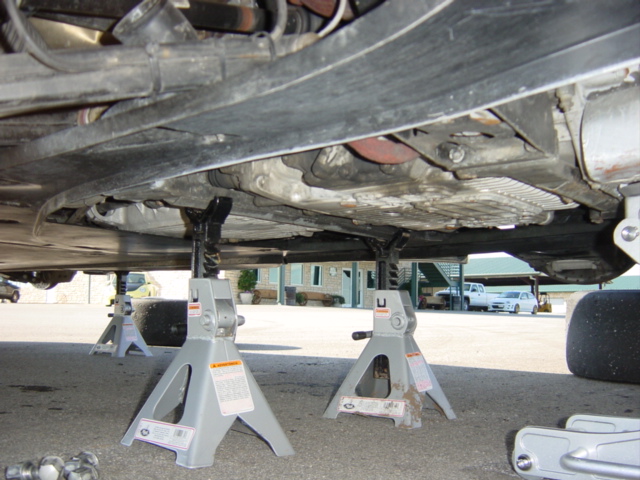| Author | Message | ||
| Carl Rose (Carl_rose)
Junior Member Username: Carl_rose Post Number: 117 Registered: 10-2002 |
Hi Mr. Lay, Here's a problem from the 4-piston Corvettes 1965-82 disk brake constant-contact system: if the rotor wears unevenly and eventually develops "wobble" (lateral runout), the caliper pistons will "follow" it, moving repetitively in/out. Over time the seals degenerate and the pistons actually "pump" air into the system. Symptoms are hard pedal after bleeding followed by soft pedal after use. Solution is to machine runout within specs (while dynamically mounted on hub). Initial diagnosis was challenging. Not sure if this applies to your problem though?  Carl Carl | ||
| Rob Schermerhorn (Rexrcr)
Member Username: Rexrcr Post Number: 681 Registered: 11-2002 |
As for inner then outer bleeder order, I guess if we tested this both ways with two cars, perhaps it would not make a difference since the air will rise to the bleeder, and fresh fluid is always a good thing. Theoretically, doing it outer first may allow a bubble to cross from inner to outer as you bleed the inner last. Some fluid may be drawn back into the caliper and air may find it's way to the outboard side, and you've already bled that one. I guess it's debatable, this is the way I've done it. | ||
| Dennis (Bighead)
Junior Member Username: Bighead Post Number: 143 Registered: 2-2003 |
Rob L: The same thing happened to me the first time I bled the calipers on my 355 (stock, not Challenge, but same setup, I think). There are two bleed screws on each caliper, on either side of the disc. I did the outboard bleed screw THROUGH the openings in the wheels, and was so proud that I did everything without having the jack the car up and remove the wheels. Then, of course, when I boasted of my cleverness, my mechanic asked me, "if you didn't take the wheels off, how did you get the wrench on the INNER bleed screw?" Doh. Rob S.: I was told to do the screws in the order in which they are DISTANT from the reservoir; in other words, do the right rear outboard then inboard, LR O then LR I, RF O then RF I, LF O then LF I -- you suggested that I should be doing the inboard before the outboard; does it really matter? If so, why? Just curious, more than anything else. thx, --Dennis | ||
| "The Don" (The_don)
Senior Member Username: The_don Post Number: 5218 Registered: 8-2002 |
Rob, Dave at Sodacom's has them. Cheap. I order mine from him | ||
| Rob Lay (Rob328gts)
Board Administrator Username: Rob328gts Post Number: 5319 Registered: 12-2000 |
I haven't been getting the correct sized cooper crush rings from the place I get the filters. Can anyone tell me the correct sizes and a good place to order a lifetime supply (I'll never sell a Ferrari) for... 355 12mm hex drain plug. 355 22mm bolt. 328 12mm hex drain plug. Thanks, rob | ||
| Rob Schermerhorn (Rexrcr)
Member Username: Rexrcr Post Number: 679 Registered: 11-2002 |
Two bleeder screws on each caliper. Bleed inner first, then outboard one. All Ferrari's starting with 348 have two bleed screws, many older models do too. Bleed in order of closer to master first. Torque bleed screws on aluminum calipers to 13 ft-lb. Very important. With repeated over torque, you'll eventually split the caliper or mushroom the material around the bleed screw. | ||
| Rob Lay (Rob328gts)
Board Administrator Username: Rob328gts Post Number: 5318 Registered: 12-2000 |
SOB, went to watch my videos last night and all you see is the dash and sky. Sometimes under heavy braking you see a glimpse of the road. I tried to fix the camera angle after having the rear view in the way last time. Too much of a hurry to test before my runs though. Oh well, with the green track, I wouldn't of been much faster, if I was at all, but I wish I could of got all those other cars in the video. | ||
| Rob Lay (Rob328gts)
Board Administrator Username: Rob328gts Post Number: 5312 Registered: 12-2000 |
Rob, umm, what's an inner bleeder?  I just saw the bleed screw on the outside top of the caliper. | ||
| Rob Schermerhorn (Rexrcr)
Member Username: Rexrcr Post Number: 678 Registered: 11-2002 |
Q1 & 2) Your procedure sounds fine, and I think you're correct about why the engine sounded different, no real problems here. I thought oil capacity is 9 liters, so 9 quarts at a change is fine, just look at the dipstick with hot oil. Q3) I've bled plenty of cars that did the same thing. Just checking: you're doing inner bleeder before the outer, right? Otherwise, sounds good. Q4) Internal construction determines rotation. Though Pirelli has changed their explanation and procedure over the last ten years. You can swap side to side, but keep the rotation direction consistent. And for the undertray, it only gets worse when you move up to a 360, so enjoy it while you can. Welcome to racing! | ||
| Dave (Maranelloman)
Intermediate Member Username: Maranelloman Post Number: 1928 Registered: 1-2002 |
Rob, I can only help with #3. Recently, we bled the 550's brakes, after 3 really hot days at TWS and a subsequent soft pedal (I suspect that I partially boiled the OEM fluid). I chose to put in SRF, so this won't happen again. Anyway, after a FULL system bleed (brakes & clutch), producing MANY bubbles from 2 calipers, and after driving it, the pedal still felt somewhat soft! So we bled all 4 calipers again, and lo & behold, bubbles appeared from 2 different ones this time. Not sure why...but I would suspect that your experience & mine are not unusual. PS: I am really bummed that I missed coming up to MSR. Don't even ask me about the M3, I am so p!ssed off...but it might be finally done this week. Ironically, I know Dennis Boulle. Wish I had had a chance to see him again... | ||
| Dennis (Bighead)
Junior Member Username: Bighead Post Number: 142 Registered: 2-2003 |
Rob: re your question #3. If you're going to the trouble to hit bleed the brakes, why not just change the fluid entirely? You'll get all the air out, and brake fluid is, relatively speaking, really cheap. This also allows you to use cheaper fluid (e.g., Ford HD), if you change it regularly, and you save money in the long run. Also, spend $40-$50 for the motive power bleeder. The best tool, IMHO, to change the fluid/bleed the brakes. It screws to the top of the reservoir, you pump up the pressure by hand (no need to a spare tire), and no need for a helper to step on the brake and yell. You just fill the power bleeder with new brake fluid, and voila. I alternate between the ATE Super Blue and Gold 2000; same formula, same fluid, just different color - makes it easy to tell when you've hit new fluid at the caliper. $10 a bottle when you buy a case. vty, --Dennis | ||
| Rob Lay (Rob328gts)
Board Administrator Username: Rob328gts Post Number: 5308 Registered: 12-2000 |
Question #4: The Pirelli Pzero slicks have directional arrows, but I don't see anything in the make of the tire that would seem to make a difference. Any problem rotating them? | ||
| Rob Lay (Rob328gts)
Board Administrator Username: Rob328gts Post Number: 5304 Registered: 12-2000 |
I had the 355 C out yesterday for 3 hard sessions. Yet again another great time and the car ran perfect. Here's all the cars out to play yesterday...  The red 355 C is Dennis deBoulle's (sp?). The two of us were the fastest on the track overall. He's run MSR with that car many times more than I have, but we were running similar times. He was probably a hair quicker. We were both a little faster than anything else out there. The Jag was so fast in the straights, only weighs 2,200 lbs. However, couldn't turn or brake. M3 was probably the next fastest, he had many mods on it too. It was awesome how he would drift it through the corners, a very good driver. I'll try to get videos up later this week. Technical Questions I put the car in the air for the first time to change the oil, inspect everything, and bleed the brakes (nice you can do without putting in the air like my Rx7).  I think I found pretty good jacking points and places for the jack stands. I wanted to ask about this rear spot for the jack stands. It's a cross member under the engine, it seems really sturdy and it's triangular, so fits well into the jack stand notches. I watched it carefully when putting weight on it and everything looked good. Is this a OK place? Also, I jacked the car up side to side, but when I wanted to raise the rear jacks I used the rear trans case as a jack point. Is that an OK place?  Anyway, everything went fine with the procedures. Removing the under aero tray is a pain in the butt. 14 or so screws just to change the oil ?!? That's going to get old. The rest was easy draining the engine and then I guess the dry sump box? That last one seemed to contain more oil than the first one. Question #1: I put 8 quarts in to start and then with the car on the stands I started it. After oil change and with new filter is there any type of pre-oiling procedure or do you just turn it on. I don't know if it was the sound echo with the car in the air or the angle the car was sitting on the jack stands, but first time I turned it on I had immediate oil pressure, but it just didn't sound good. I turned it off and after putting down on the ground it sounded normal. Why do you think it was, can the angle of the car on jacks cause it to starve for oil in places? Question #2: After adding another quart it was at a good level. How many quarts do you usually end up adding with a filter change. I ended up at 9, but I think it might need just a little more. Question #3: Bleeding brakes was easy. The color looked good and no bubbles. However, after pumping it and waiting for several seconds, bubbles would eventually start coming out. I would think if there was air in the system it would appear right at first or does it take 10-20 seconds for the bubbles to appear like I saw? I'm thinking maybe air was getting between the hose and bleed screws after a little and that's why it looked like bubbles. What do you think? Bubbles from the system or from the rubber hose? That's all I can think of for now. More later. |